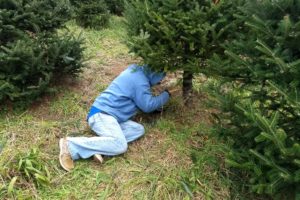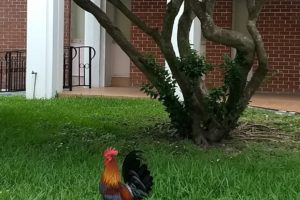While this is our last afternoon at Mesa Verde, this post covers a period of time from AD 800 – 1200 when people were living on top of the mesa, farming their land, building their homes, and raising their families.


In the mid-1100s, at least 35 villages of family homes and public buildings set among small farm fields would have been living here within a 1/2-square mile area.

Far View House – AD 1000
Far View House commands a stunning view of both the Mesa Verde canyons and nearby mountains in 4 states. While trees block some of the view today, in residents in AD 1000s could look out to the far mountains from their second-story rooftops.
We didn’t see a second-story, but in 1916 archeologists found a large pile of building stone covering the lower walls, far more stones than a one-story building would require. They also observed sockets, small openings built into the masonry to support wooden beams. These beams formed the ceiling of the first story and supported the floor of the second story.

What we see of Far View House today shows the final stage of Pueblo people occupying this site. Archeologists found older buried foundations, beams, and broken pottery beneath these walls, showing this was a popular location for centuries.

Often the doorways align, and a special type of masonry is used. Great Houses are built with a plan in place ahead of time, while most residential pueblos or later cliff dwellings added rooms as they were needed. Sometimes a great kiva is nearby, normally occupying a prominent place on the landscape.



views of Far View House



Pipe Shrine House – AD 1000

This sign talks about their dryland farming techniques (instead of irrigation) that we’ve mentioned in earlier posts.

He called it Pipe Shrine House because his workers found “a full dozen decorated tobacco pipes” (next picture) and some small carved stone figures and pottery in an enclosure in one of the kivas that he interpreted as a religious shrine.




Coyote Village – AD 975

Starting before AD 975, it was built, occupied, abandoned, rebuilt, and reoccupied several times. Each time the people reused some of the stones and timbers, adding to or remodeling rooms as needed.

This style is common in Mesa Verde and may indicate a local style popular here in AD 1200s. One kiva was connected to the tower by an underground tunnel.



views of Coyote Village





Far View Reservoir – AD 950

For a while we thought we might be on the wrong road, but then we found the reservoir.

inside view as we . . . 
were walking up to the reservoir

It did collect water, as we’ll soon see, but it’s construction would have required an enormous investment of time and energy.
The reservoir to catch and store water had been surrounded by corn fields and was frequently visited by the residents over the years. Evidence from tree ring widths indicates that the amount of rainfall today is similar to rainfall a 1000 years ago, suggesting that water stored here had to come from storm runoff and snow melt.
The reservoir is about 90 feet in interior diameter and has constructed embankments on the south and east sides, steps on the exterior, and a ramp on the interior.


Without strong animals or wheeled vehicles, they personally carried tons of stone, soil, and water to build this reservoir and their multi-story buildings, aligning structures with cardinal directions (north, south, east, and west), local landmarks, and celestial events.

Of the potsherds found here, about 86% were the decorated black-on-white ollas (ceramic jars) that we’ve seen.


The ancient people started by scooping mud out of the low spot where the center is today. Later they built a stone wall and piled more mud behind it, eventually building a second wall and piling still more mud behind it.
The continuous wall lining the interior was built last.


Megalithic House – late AD 1100s
One of the good questions asked in the brochures we read was why would people live here on mesa top instead of the other broad valley areas north of here. We learned that this area provided the following:
- Areas of rich deep soil on the mesa tops and in drainage areas: Hundreds of check dams to college water and soil washed downhill during storms make these ideal farming terraces.
- Warmer temperatures and a longer growing season: Since cold air sinks into the surrounding valleys and canyons, nights on the mesa tops tend to be warmer and so better for growing food crops they depended on.
- A 1500-foot change in elevation in a short distance: Many different edible and useful plants grow at different elevations. The mesa top residents could reach a great variety of plants that ripened at different times and so extend the season for gathering food and essential supplies. We’ve already looked at the yucca plants and what they provided. Tiny seeds from rice grass added nutrients and calories to meals. Nuts harvested from pinyon cones have provided food for those living in the Southwest for many centuries.



Many other families lived in similar small pueblos nearby and throughout the region.
Gardens of corn, beans, and squash would have surrounded this house and nearby sites. Ancient farmers also raised turkeys for their feathers, bones, and meat. They also kept small domesticated dogs.
Only about half of the house is visible today. Leaving a structure unexcavated or backfilling it after study protects it from exposure and deterioration.

Many other families lived in similar small pueblos nearby and throughout the region.



Very old strains of corn are still grown for food and ceremonial use by descendants of people who lived here.
inside



Far View Tower – AD 1200


Farms on this part of the mesa were healthy with deep and fertile soil, but farmers kept working to improve their land. Hundreds of check dams are found in the area built across shallow drainage areas to catch and retain moisture and soil over time.


The 2-story round tower here was built around AD 1200. At least 60 towers have been found in mesa top excavated areas. In some locations the towers commanded an expansive view of the countryside. Since most of the trees would have been cut down for fuel and building materials, these towers would have been helpful for seeing what was in the distance.



last ranger talk

He commented that Smokey Bear now doesn’t want us to help fight forest fires but to fight wild fires. Forest fires are normally natural and helpful; wild fires aren’t. Have you seen this change in the Smokey the Bear signs?

We asked one of the rangers about the mountain range we saw east of Mesa Verde that still had snow on top of the peaks, wondering if it was part of the Rocky Mountain range. She said it wasn’t and then laughed. The joke was that the snow on that mountain range was what provided water to Mesa Verde and that the rangers had a bet on when the snow would be gone.
She also told us that the park area gets water from monsoons moving north out of Arizona. This surprised us because we were used to the desert regions we had been in that got very little rain and had assumed that the Mesa Verde region of the 4 Corners was also high desert. But that wouldn’t explain the crops that the Pueblo people had grown and that still grow in the valleys around us. Their normal rainfall of 18 inches is a far cry from what we’ve been experiencing.
final observations
We’ve been thinking a lot about what we’ve learned while here and thought we’d share our observations with you.
- When a group of people go from nomadic hunting (like the pioneers we’ve looked at who kept moving west) to farming, they have to go from living lean to building homes and adding possessions.
- Possessions get fancier, and religions get more involved and complicated.
- These Pueblo people were extremely intelligent and hard-working men and women, figuring out how to manage, subdue, and grow in their environment.
- They were strong.
- Their family’s life was important to them.
What have you been learning from our time at Mesa Verde National Park? Let us know.




